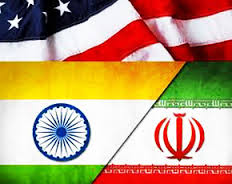The Tehran-New Delhi Axis
 Iran, with its Islamic regime, seems a strange ally of India, a predominantly Hindu democracy. But the two nations have been overcoming past antagonisms and developing closer ties that will affect not just Southwest Asia and the Middle East but also the United States. Their new relationship could powerfully influence such important matters as the flow of energy resources, regional and worldwide efforts to combat terrorism, and political developments in Pakistan, Afghanistan, and other states in Central Asia. The consequences will not always suit U.S. interests.
Iran, with its Islamic regime, seems a strange ally of India, a predominantly Hindu democracy. But the two nations have been overcoming past antagonisms and developing closer ties that will affect not just Southwest Asia and the Middle East but also the United States. Their new relationship could powerfully influence such important matters as the flow of energy resources, regional and worldwide efforts to combat terrorism, and political developments in Pakistan, Afghanistan, and other states in Central Asia. The consequences will not always suit U.S. interests.
Before the Islamic revolution, in 1979, Iran’s ties with the West greatly vexed India, which had championed the non-aligned movement. Those concerns disappeared after the revolution, of course, but were soon replaced by concerns about Iran’s support of Kashmiri aspirations and its efforts to spread Islamic revolution to other Persian Gulf states. Nevertheless, after the Cold War ended, Iran and India discovered that they shared a stake in checking U.S. global power, opposing the Taliban in Afghanistan, fighting narcotics trafficking in Asia, and developing mutually beneficial energy options.
More recently New Delhi and Tehran have found common ground in the reconstruction of Afghanistan and in the preservation of Pakistan as a functioning state (because its collapse would pose even more of a threat to India than its survival). The two have also recognized that closer ties would help each nation meet important needs of its own: for Iran, India could be a source of technical expertise, industrial goods, and foreign investment; for India, Iran could be a much needed additional source of energy and could serve as a gateway to Central Asia (which India seeks in order to develop new markets) and as a new military flank against Pakistan. In the realm of domestic politics, too, India has strong reasons for wanting improved relations with Iran. As India witnesses a surge in Hindu nationalist politics and sentiment, it needs to signal to its increasingly marginalized and disaffected Muslim population (the second largest in the world) that it has Muslim interests in mind.
The most important milestone in the development of Indo-Iranian ties came this past January, when Iran’s President Mohammad Khatami visited New Delhi as the chief guest for the Indian Republic Day parade—an honor reserved for the closest friends of India. During the visit Khatami and India’s Prime Minister Atal Bihari Vajpayee signed an accord that focuses on economic, scientific, and technological ties between the two countries and that also provides a framework within which to explore a defense relationship. This new relationship began to take shape in March, in a small-scale naval exercise that Indian diplomats refer to as a “port call.” Meanwhile, Iran seeks to buy arms and spare parts from India, which is steadily acquiring the capacity to manufacture a wide array of Russian military hardware, and India sees Iran as a major buyer that could help to defray the costs of this manufacturing program.



